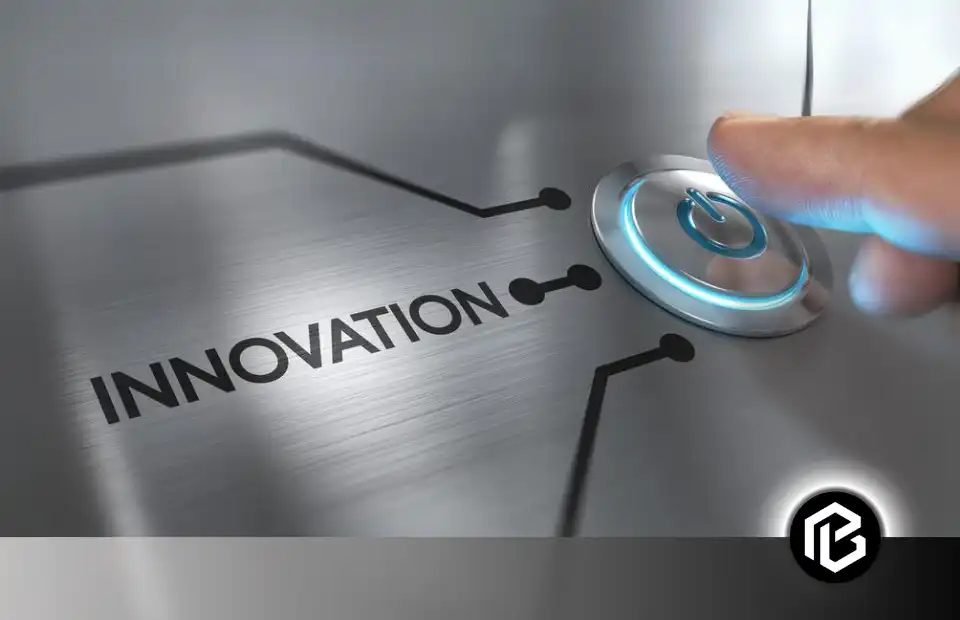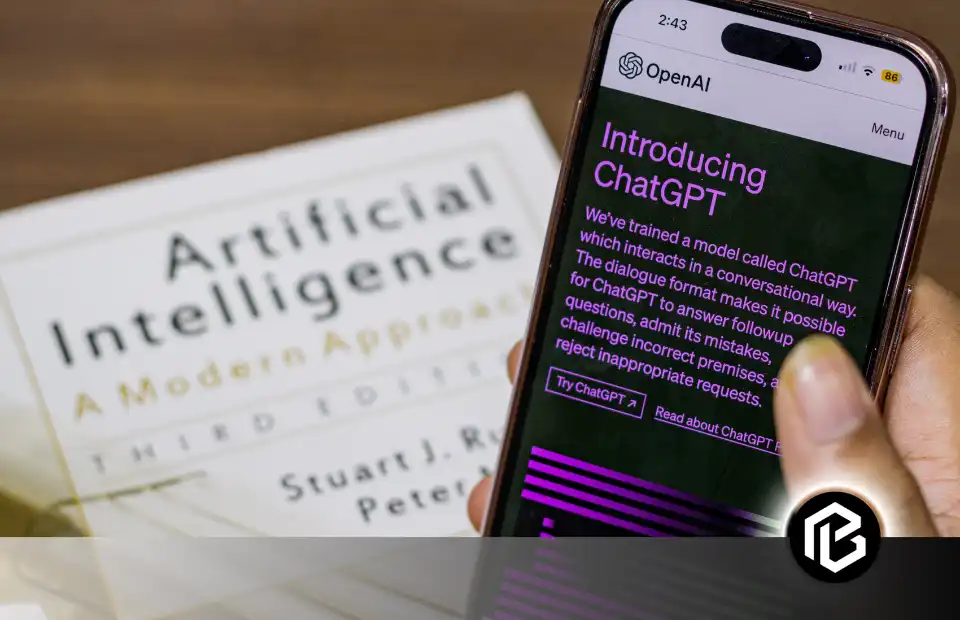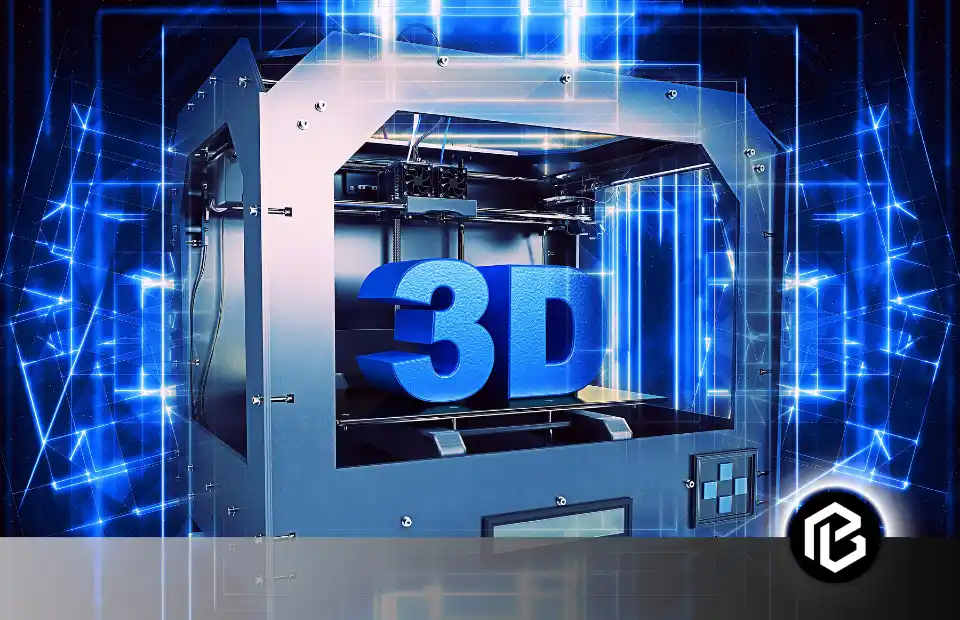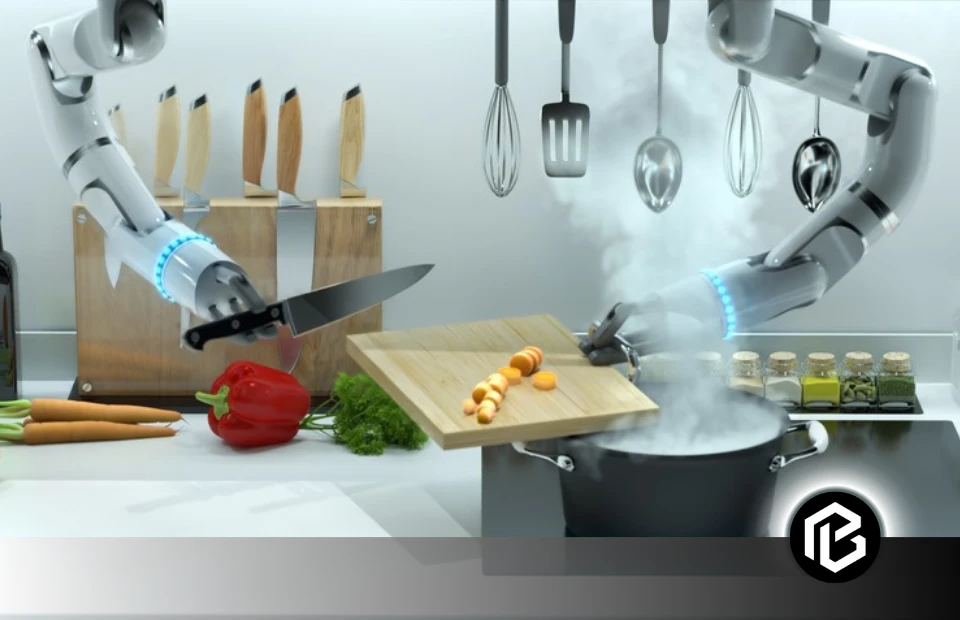We live in an age where technology is no longer limited to smartphones or gadgets. It is about creating technological advancements that have the potential to change the world never seen before. The future of the technological world is here! 2024 is a year full of computing innovations. The things that once seemed our dreams are now a technological reality. Let’s explore the best computing innovations and blow your mind!!
- 1. Artificial Intelligence (AI)
- 2. Internet of Things (IoT): New Computing Innovations
- 3. 5G Networks
- 4. Blockchain Technology
- 5. Virtual Reality (VR) and Augmented Reality (AR)
- 6. Autonomous Vehicles
- 7. Biometric Authentication
- 8. Quantum Computing
- 9. Robotics and Automation
- Conclusion
- Frequently Asked Questions on Computing Innovations
1. Artificial Intelligence (AI)
As we all know, Artificial Intelligence (AI) is the boom in the market. It has transformed the way we live, learn and work.
Companies like Apple, Google, and Tesla have been investing heavily in AI. AI has completely transformed the way businesses interact with their customers and generate their revenue. Businesses use AI to process large data and decide how to give themselves an instant boost and success.
Moreover, from augmented reality to cloud computing, AI is taking the technological world to a whole new level.

1.1 Machine Learning
Machine learning is a branch of AI that trains machines on datasets rather than hard coding. Using different machine learning algorithms and models, machines can be trained to process and analyze different datasets. This analysis helps make predictions.
Machine learning is applied in almost all our routine tasks. It is being applied in medicine, finances, and businesses to enhance and improve quality of life.
Machine learning innovation is evolving the industry by automating multiple tasks ultimately saving a lot of time and human efforts.
1.2 Natural Language Processing (NLP)
The field of natural language processing (NLP) is a branch of artificial intelligence (AI) that involves the understanding, generating, and manipulating of human language through the use of computers.
NLP has been used by several consumers who have yet to be aware of it. For instance, NLP is the core technology behind virtual assistants, such as Oracle Digital Assistant (ODA), Siri, Cortana, or Alexa. When we ask questions to these assistants, they understand and respond in natural language that is humanly understandable. All this is possible due to natural language processing (NLP).
1.3 Computer Vision
Like human visions are cameras capturing the world, computer visions enable machines to observe and understand visual data. Computer vision involves training computers to analyze data based on images and videos. Doesn’t it sound crazy that computers can see and respond to visual data? Computer visions can perform multiple tasks including image classification, object detection, and object tracking.
Computer visions enhance businesses by understanding customer behavior and making accurate recommendations.
2. Internet of Things (IoT): New Computing Innovations
The Internet of Things (IoT) is the network of physical devices, vehicles, and objects. These physical objects are embedded with different sensors and software to collect data. The Internet of Things (IoT) enables smart devices to communicate and share data.
The Internet of Things (IoT) provides multiple benefits, including improved efficiency, data-driven decision-making, and enhanced customer experience by using smart technology.
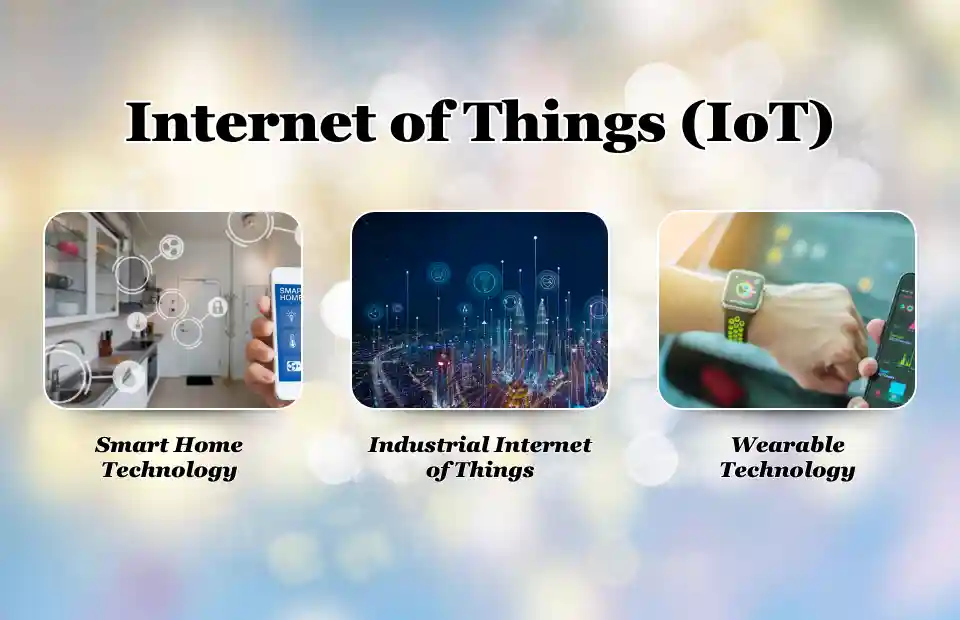
2.1 Smart Home Technology
Smart home technology has been derived from the Internet of Things (IoT). This technology is to convert your homes into “smart homes” by using smart devices. These smart devices include smart door locks, cameras, lights, televisions, Amazon Alexa, and many more. Smart home technology provides homeowners with increased security, cost savings, and a convenient living style.
2.2 Industrial Internet of Things (IIoT)
As to its name, the Industrial Internet of Things (IIoT), refers to the network of sensors, applications, and equipment that work to collect, analyze, and monitor data of industrial applications.
Organizations adopting Industrial Internet of Things (IIoT) devices are getting a wealth of data to perform effective operations for the success of their industries.
2.3 Wearable Technology
Wearable technology is any variety of technology that is designed in a way to be worn on the human body. Wearable Gadgets can into existence for the betterment of humans. For example, it can be used in the medical field to monitor patients’ health. This monitoring data can help doctors understand the patient’s situation and how to further treat the disease.
There are multiple uses of wearable technology in routine tasks.
If we specifically talk about wrist wearable devices, then there is a rise of almost 66 million units to 105 million units in 2023.
3. 5G Networks
The 5G network is one of the top computing innovations. 5G is the fifth-generation technology standard for cellular networks. The primary objective of the 5G network is to enhance the speed and bandwidth of wireless networks.
Moreover, 5G is designed not only to connect humans virtually but also multiple machines and objects virtually increasing the quality of life. Multiple technologies that require high-speed connections and high-quality data transfer greatly benefit from the innovation of the 5G networks.

3.1 Enhanced Mobile Broadband
Enhanced mobile broadband (eMBB), is one of the main features of the 5G network. The eMBB not only provides higher data rates but also enhances user experience by providing 360 live streaming, high-quality virtual and augmented reality applications, and much more.
3.2 Internet of Things (IoT) Connectivity
5G networks have enabled ultra-fast data transfer and low latency rates. These features of the 5G network allow the Internet of Things (IoT), to receive and transfer real-time data quickly than ever. The data collection and transfer help efficient and reliable use of technologies such as autonomous vehicles, virtual and augmented reality, and remote surgeries.
3.3 Low Latency Communications
The innovation of the 5G network has changed the world with its higher data transfer speeds and ultra-low latency rates than ever. The latency rate is the delay between sending and receiving information. In the 4G networks, we have a latency rate of 200 milliseconds whereas in the 5G networks, this latency rate has reduced to only 1 millisecond.
Isn’t it amazing how rapidly technology is evolving?
4. Blockchain Technology
Let’s understand blockchain technology in simple terms. A decentralized system means everyone can access it and is difficult to make modifications is called a blockchain system. Blockchain came in the 1990s but was implemented in 2009. With the help of blockchain technology, we can track the records easily and store them securely.
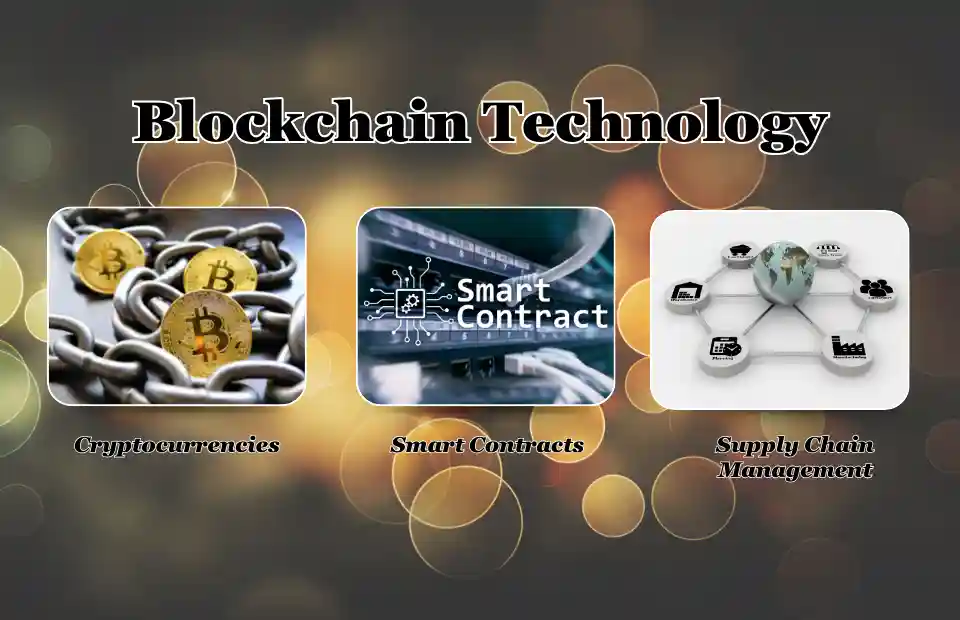
4.1 Cryptocurrencies
Cryptocurrency is the mechanism of exchange. Cryptocurrency is created and electronically stored on the blockchain. Blockchain technology is essential in understanding the structure of cryptocurrency transactions. The information about each transaction of cryptocurrency is stored in a block and this block is added to the existing chain of blocks. The chain of blocks is secure, transparent, and viewable to everyone.
4.2 Smart Contracts
The smart contracts are stored on the blockchain and they execute automatically when a predetermined condition is satisfied. There is no intermediate involvement of any third party. The workflow executes automatically when any predetermined terms are met. The smart contracts work by following the If/then statement. This condition is written as a code in the blockchain.
4.3 Supply Chain Management
With the use of blockchain technology in supply chain management, the potential of the supply chain grows exponentially. Blockchain technology can help in the efficiency of the supply chain industry by recording the information of each transaction in the block of the blockchain. These recordings are then distributed to multiple computers which makes the information highly available as well as transparent. Moreover, security also becomes very tight with the use of blockchain as each block is connected to the other and so on.
5. Virtual Reality (VR) and Augmented Reality (AR)
Let’s talk about the fastest and most fascinating growing technologies that are revolutionizing the present and future. These technologies are virtual reality (VR) and augmented reality (AR). Virtual and augmented reality are extending reality by providing users with digital environments of different domains. Virtual reality uses special headsets that create a simulated environment for the user which helps the user to immerse into an experience that is entirely different from reality.
Morton Heilig invented the first virtual reality device in 1957 called Sensorama. On the other hand, augmented reality projects computer-generated augmentations that are on top of reality.
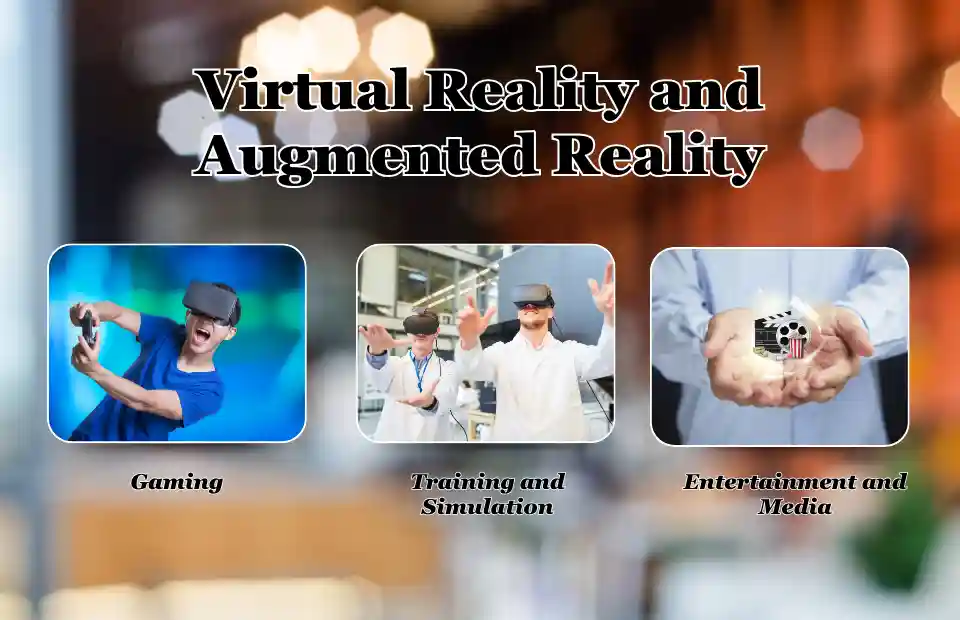
5.1 Gaming
All gaming lovers want to play games that have high resolutions and premium quality. Playing games becomes more interesting if they look realistic. There are successful implementations of virtual reality in gaming. Multiple large gaming organizations have transferred their games to virtual reality to enhance the user experience. From flying in the air to diving in the deep oceans, virtual reality in gaming has made it all possible.
5.2 Training and Simulation
Virtual reality training and simulation are used to train humans in a digital environment of real-life scenarios. The humans are provided with a 360-degree active environment. The digital environment also consists of relevant sounds to provide the experience of a very realistic environment.
5.3 Entertainment and Media
The invention of virtual reality (VR) and augmented reality (AR) has highly dissolved the barrier between realistic and virtual environments. In the entertainment industry and media domain people can watch movies, and shows, and enjoy concerts as if they are physically available there. The user experiences an immersive and interactive feel of the virtual reality. According to the track record of 2023, an estimated 171 million virtual reality users are worldwide.
6. Autonomous Vehicles
Autonomous vehicles are also called self-driving cars. These advanced forms of vehicles can operate without any help from humans. How amazing! Autonomous vehicles use smart sensors, AI, and Machine learning algorithms to recognize their path and destination. The most cool thing is that these smart vehicles also make decisions and identify objects. Autonomous vehicles are developed to improve road safety, reduce traffic congestion, and enhance mobility for everyone.
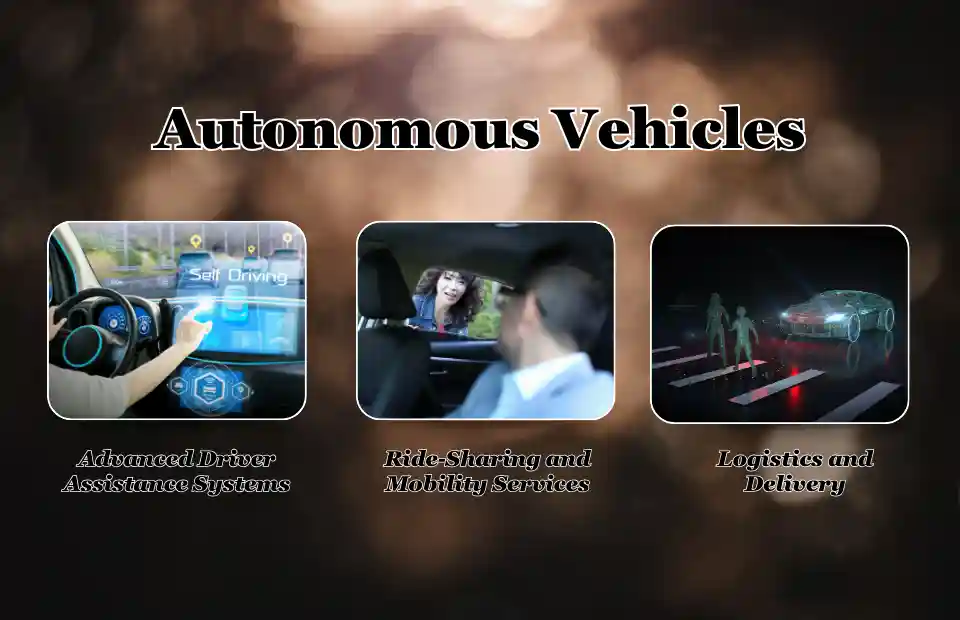
6.1 Advanced Driver Assistance Systems (ADAS)
The Advanced Driver Assistance System (ADAS) is made for drivers and is very helpful in many aspects of driving like parking, lane keeping, adaptive cruise control, and collision avoidance. This system uses different technologies based on sensors, cameras, and AI algorithms to provide real-time assistance and improve driving safety.
6.2 Ride-Sharing and Mobility Services
Ride-sharing and mobility services like Uber, Lyft, and public transportation completely revolutionized the way people commute and access transportation. These services offer convenience, flexibility, and cost-effectiveness, making them increasingly popular in urban areas. Ride-sharing and mobility services will continue to grow, integrating advanced technologies like electric vehicles, autonomous driving, and smart city infrastructure. This will increase the sustainability and efficiency of transportation systems, reducing traffic congestion and emissions.
6.3 Logistics and Delivery
Logistics and delivery have had amazing transformations in recent years, with the rise of e-commerce and the need for faster, more efficient delivery services. Technologies like drones, autonomous vehicles, and smart warehouses have been adopted to optimize the logistics process and improve the overall delivery experience.
Advanced technologies like AI and IoT are used to perform operations and enhance customer satisfaction. Autonomous drones and ground vehicles play an important role in delivery, providing faster and more efficient services.
7. Biometric Authentication
Biometric Authentication uses different biological characteristics like fingerprints, facial recognition, and voice recognition to verify a person’s identity for security purposes. In recent years, this technology has become very popular because it is the best way to secure data and provides a more convenient alternative to traditional password-based authentication methods.
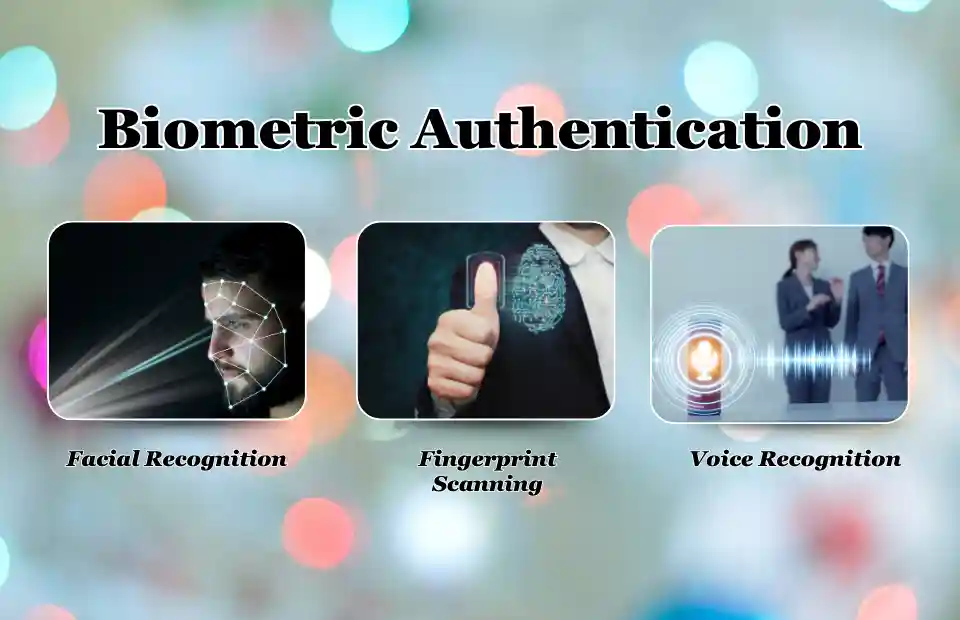
7.1 Facial Recognition
It is a form of biometric technology that identifies the user by recognizing his facial features. Facial Recognition technology has many applications in security, law enforcement, and access control. This technology provides high accuracy and faster processing speed, so this will increase its adoption in many sectors, improving security and convenience.
7.2 Fingerprint Scanning
In fingerprint scanning technology, the fingerprints of a person are used to identify and give access to a system. This technology is used in smartphones, security systems, and access control devices. It’s very popular as it provides a secure and convenient way to verify identity.
7.3 Voice Recognition
Voice recognition is a biometric technology that identifies and verifies a person by recognizing his voice. It has applications in many industries, such as voice assistants, call centre authentication, and hands-free device control. The advanced voice recognition system provides high accuracy and a better understanding of different accents and languages.
8. Quantum Computing
Quantum computing consists of advanced computing techniques to solve complex calculations at an unprecedented speed. The qubits in quantum computers are capable of occupying multiple states at once, allowing them to process information in a way that is fundamentally different from traditional computers.
Quantum computing is used in many fields including cryptography, drug discovery, optimization, and simulation.
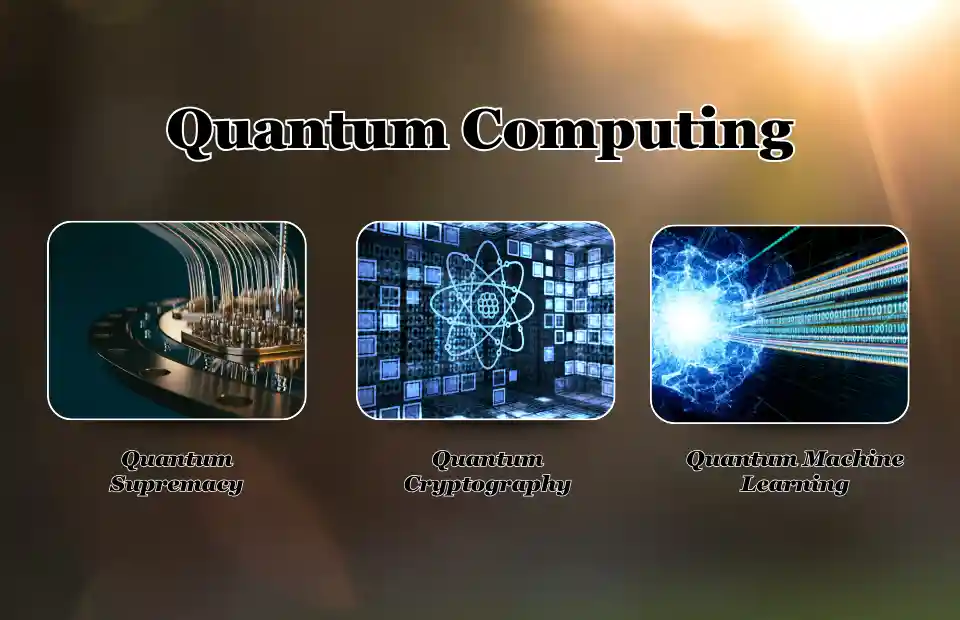
8.1 Quantum Supremacy
Quantum Supremacy is simply the point at which a quantum computer solves a problem that cannot be handled by most powerful classical computers. In 2024, the achievement of quantum supremacy is a breakthrough in the field of quantum computing. This technology increases the potential of quantum computers and also makes the way for further advancements in this field. But we have to understand that quantum supremacy does not necessarily mean that quantum computers will be able to solve all problems more efficiently than classical computers.
8.2 Quantum Cryptography
To protect Data privacy, Quantum Cryptography is used. Quantum Cryptography uses the rules of quantum mechanics to secure communication. It is based on the fact that measuring a quantum system disturbs its state to make it impossible to intercept and copy quantum information without being detected.
Quantum cryptography plays an important role in securing communication channels against potential threats from quantum computers. As classical encryption methods become vulnerable to quantum attacks, quantum cryptography will provide a secure alternative for protecting sensitive data.
8.3 Quantum Machine Learning
Quantum machine learning is a mixture of quantum computing and machine learning algorithms. This technology is used in many fields like pattern recognition, optimization, and data analysis, it solves the problems that are currently impossible to understand by classical computers.
Quantum machine learning also advances in many other fields like drug discovery, financial modelling, and material science. However, there are also some challenges are concern in developing efficient quantum algorithms and merging them with existing machine-learning frameworks to reach their full potential.
9. Robotics and Automation
Robotics and automation are growing very fast. In robotics and automation, we are generally concerned with designing, constructing, and operating robots and automated machines that perform tasks by themselves or with human intervention. This advanced form of technology is used in many industries like manufacturing, healthcare, agriculture, etc.
In recent years, Robotics and automation becoming more and more advanced. With the help of AI, machine learning, and advanced sensors, Robots work efficiently and increase overall productivity. However, some concerns should be considered to ensure their successful integration into society. These concerns are job displacement, privacy issues, and the responsible development and deployment of these technologies.
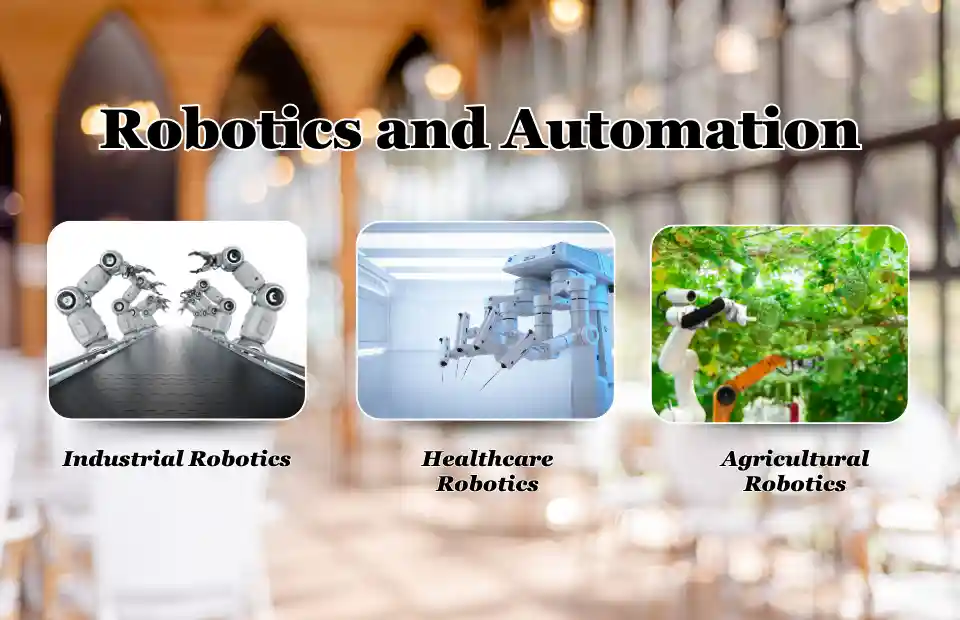
9.1 Industrial Robotics
The use of robots in manufacturing and production processes to perform operations like welding, assembling, painting, and material handling is called Industrial robotics.
These robots are mainly designed to increase efficiency, reduce cost, and improve quality.
Industrial robotics work alongside human workers and do tasks easily. These intelligent machines offer more flexible and collaborative solutions.
9.2 Healthcare Robotics
The use of robots in healthcare to perform tasks like surgical assistance, patient care, rehabilitation, and medicine delivery is now possible. These specially trained robots are designed to improve patient outcomes, reduce healthcare costs, and enhance the overall efficiency of healthcare systems. Healthcare robotics improve patient care, reduce human error, and address the growing healthcare service demand.
9.3 Agricultural Robotics
Advanced machinery and Agricultural robots are used in planting, harvesting, monitoring, and maintenance of fields. These agricultural robots include smart irrigation controllers, smart drones, and advanced sensors. Agriculture Robotics are used to increase efficiency, reduce labour costs, and improve crop yields.
Conclusion
In conclusion, we are in an era where technology is blowing our minds with continuous revolution. The future is here! From computer visions enabling computers to see to agriculture robots allowing automation in agriculture, the best computing innovations are here! These computing innovations highly automate our routine tasks, reduce manual efforts, and increase efficiency. It’s the start of introducing computing innovation and still many more to come! Stay happy!
Frequently Asked Questions on Computing Innovations
What new technology is coming in 2024?
In 2024, we will dive into the whole next level of what virtual reality (VR) and augmented reality (AR) can make possible for us.
What is the best technology to learn in 2024?
The best technologies to learn in 2024 are:
- Artificial Intelligence
- Internet of Things (IoT)
- 5G Network
- Blockchain Technology
- Virtual Reality (VR) and Augmented Reality (AR)
Which technology is most in-demand?
Robotics technology is most in demand. Mastering robotics can open up a whole world of opportunities as its market is increasing exponentially.
What are the top high paying tech skills for 2024?
The top 5 high-paying tech skills for 2024 are:
- Artificial Intelligence
- Data Scientist
- Machine Learning
Which technology is booming now?
Quantum Computing is the near future. All the massive companies like Google, Amazon, and Microsoft are heavily investing in quantum computing as its market is projected to grow by millions.


